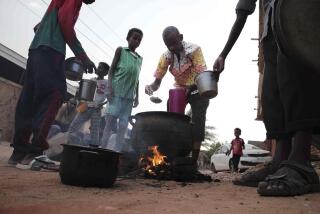Bullets, Confusion Filled Air in Sadr City
- Share via
BAGHDAD — It turned nasty at 5 p.m.
A U.S. military patrol was navigating the pitted streets of the Baghdad slum that is the stronghold of firebrand cleric Muqtader Sadr late Sunday afternoon when it ran into about 30 members of the cleric’s personal volunteer army.
But militia members rebuffed orders to lay down their arms. They and supporters hidden in a maze of surrounding buildings showered the Americans with small-arms fire, pipe bombs and rocket-propelled grenades.
The echoes of gunfire raining down from the rooftops sent Iraqi police fleeing their precincts and forced the American patrol to duck into an abandoned building. Two other patrols wound their way into the heart of the slum, and they were attacked almost simultaneously on all sides. Militiamen toppled market stalls into the narrow streets to create roadblocks, and combat continued as shadows lengthened and night fell.
It took more than four hours and a dozen tanks to quell the fighting. When the bullets finally stopped, dozens of Iraqis and eight U.S. troops were dead, with 40 more Americans wounded.
On Monday, military officials had only started to reconstruct the chaotic chain of events that led to what commanders said was the largest sustained fighting they’d seen in Baghdad since President Bush declared an end to major combat in May.
Even the number of enemy fighters was guesswork, put at anywhere from 600 to 1,000.
“There is nothing more confusing -- literally in the entire universe -- than an ambush, especially one where the buildings and the road networks are so narrow,” said Maj. Gen. Martin Dempsey, commander of the 1st Armored Division, which is based in Baghdad. “You’re not exactly certain whether you’re being shot at by three people, or 33.”
That was true for both the soldiers and the bystanders.
At 5 p.m. Sunday, Shakur Abdul Hussein, a 35-year-old engineer who had just finished the ritual washing of his hands to pray, was standing in a mosque courtyard in the heart of Sadr City, the slum named after Muqtader Sadr’s late, revered father. The empty streets suddenly echoed with gunfire, and people poured from their homes with weapons.
Moments later a bullet ricocheted off a wall and sliced through Hussein’s chest, puncturing a lung. Monday morning he lay on a narrow hospital bed, a tube in his chest, still trying to figure out what had happened.
“I thought the Americans were just trying to scare people and make them upset” by shooting in the streets, Hussein said. “I had no idea [Sadr’s militia] had taken over police stations.”
The situation at the police stations was the reason the U.S. patrols rolled into Sadr City in the first place.
Military officials had heard that the cleric’s followers in the holy city of Najaf, 90 miles south of Baghdad, had attacked a coalition base during a noontime demonstration. They said they also discovered through intelligence that Sadr was directing his followers in the capital to seize police stations and government buildings. The military officials sent in troops to watch the buildings and disarm militia members.
The first ambush is believed to have killed four soldiers and injured several others, officials said. Outnumbered, the soldiers fell back roughly 300 yards to the abandoned building and dug in there, Dempsey said. He would not identify the unit because he was uncertain whether relatives of the slain troops had been notified.
Over the next 2 1/2 hours, quick-response forces with Bradley fighting vehicles rolled into the area, only to be pinned down by heavy fire from black-clad militia members hiding on rooftops and in alleyways, officials said. An armored personnel vehicle and a truck were destroyed, and the casualties mounted.
“There was constant pressure, but not constant firefights,” Dempsey said. “There wasn’t a time when the soldiers in there could have simply stood up and said, ‘OK. That was interesting. Let’s leave now.’ Whenever they moved, there was somebody trying to suppress them.”
American troops managed to reach their wounded and began pulling them out. Military officials said they got unexpected help from some Iraqi civilians who offered their cars and, in one instance, a bus, to take wounded troops to safety.
The record of Iraqi police, Dempsey said, was more “mixed.”
As the police began to abandon smaller stations -- at least two were vacated when the shooting started -- Sadr’s militia swept in and occupied them. The police congregated in the main station in the heart of the slum. Only some helped the American troops.
“We had a mixed response from the police,” Dempsey said. “We had some who were very courageous and stayed with us, and we had some that were very uncourageous and did not stay with us.”
At a nearby hospital, staff members had to crouch inside because the bullets were flying. Bodies were piling up in the building’s courtyard, and an ambulance driver trying to bring more in was shot.
Finally, about 9 p.m., the tanks arrived. The wounded soldiers were pulled out, attack helicopters swooped overhead and sporadic gunfire continued until about midnight. As dawn broke, American troops had flushed the militia members from police stations and one government building, Dempsey said.
Hospitals reported at least 38 Iraqi deaths and 163 injuries.
U.S. troops set up checkpoints on many of the roads to Sadr City and frisked young men for weapons.
Dempsey said his units were eager to find Sadr’s militia members. “They’ve essentially declared themselves hostile to us,” the general said, “so we’re looking for them.”
--- UNPUBLISHED NOTE ---
In stories after April 9, 2004, Shiite cleric Muqtader Sadr is correctly referred to as Muqtada Sadr.
--- END NOTE ---
More to Read
Sign up for Essential California
The most important California stories and recommendations in your inbox every morning.
You may occasionally receive promotional content from the Los Angeles Times.












